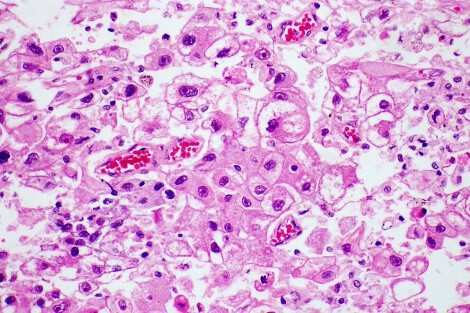A study presented today that evaluated an investigational dosage of once-daily ledipasvir 45 mg/sofosbuvir 200 mg (LDV/SOF) in children aged six to 11 years infected with the Hepatitis C virus (HCV), found that 99% of children (n=89/90) had undetectable levels of HCV-RNA 12 weeks after treatment. The study, presented at The International Liver Congress™ 2017 in Amsterdam, The Netherlands, also showed that the fixed-dose combination of LDV/SOF was well-tolerated, and no patients experienced a serious adverse event considered related to the study drug.
Around 180 million people globally have chronic HCV infection,1 including approximately 15 million people in the EU.2 The prevalence of HCV infection in children varies from 0.05%-0.36% in the United States and Europe and up to 1.8%-5.8% in some developing countries.3 While direct-acting antivirals have been used to treat and cure adult patients with HCV,4-7 until now children have been mainly treated for 24 to 48 weeks with pegylated interferon plus ribavirin (RBV), an older treatment which causes severe side effects.8
“Direct-acting antivirals have transformed the treatment of adults with chronic HCV, however, studies of these new therapies in children are required,” said Dr Karen Murray, University of Washington School of Medicine and Seattle Children’s, Seattle, United States, and lead author of the study. “These data establish the use of the oral direct-acting antivirals as an important treatment option in HCV-infected children aged six to 11 years old.”
This ongoing, open-label study enrolled 90 children aged between six and 11 years with chronic HCV, mostly genotype 1 (n=86). Children with HCV genotype 1 infection received 12 weeks of treatment (n=85) or 24 weeks of treatment if they had cirrhosis and failed prior treatment with pegylated interferon plus RBV (n=1); genotype 3 patients received LDV/SOF plus RBV for 24 weeks (n=2); genotype 4 patients received LDV/SOF for 12 weeks (n=2). Most children were male (59%), white (79%), treatment naïve (80%), and vertically infected (97%). Of the study population, 89/90 achieved a sustained virologic response 12 weeks after treatment (SVR12); one treatment-naïve genotype 1 patient with cirrhosis relapsed. No children discontinued the study due to side effects or had a severe or life-threatening adverse event related to the study drug. The most common side effects reported in 10% or more of patients were headache, fever, abdominal pain, diarrhoea, vomiting, cough, fatigue, sore throat and nausea.
“This study is a breakthrough for the management of children aged six to 11 years old with Hepatitis C, demonstrating that the new DAA regimen is highly efficacious and, more importantly, safe in this group of HCV-infected children”, said Prof Frank Tacke, University Hospital Aachen, Germany, and EASL Governing Board Member.


